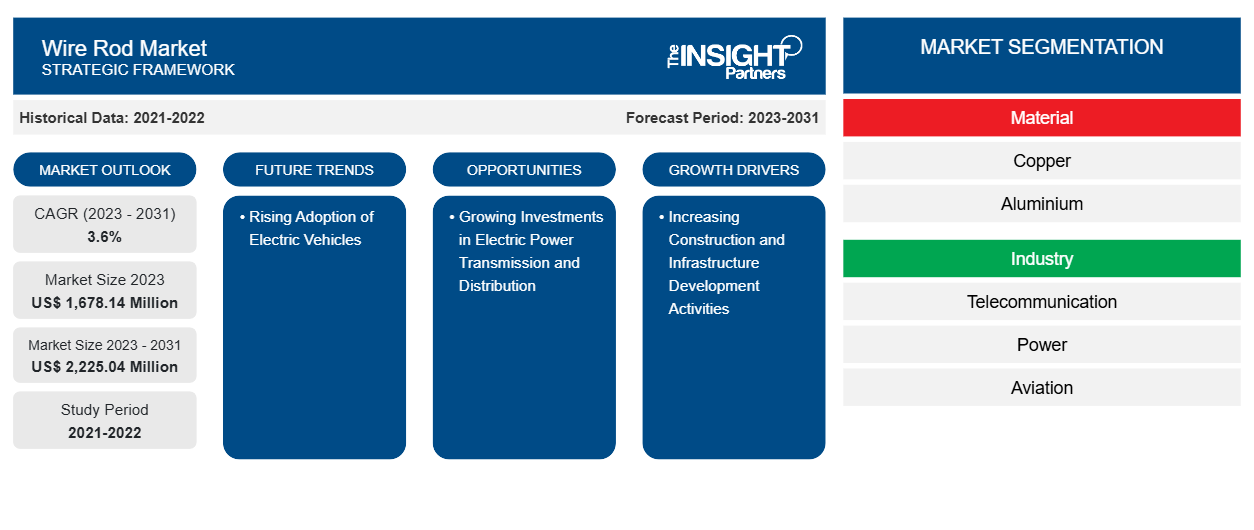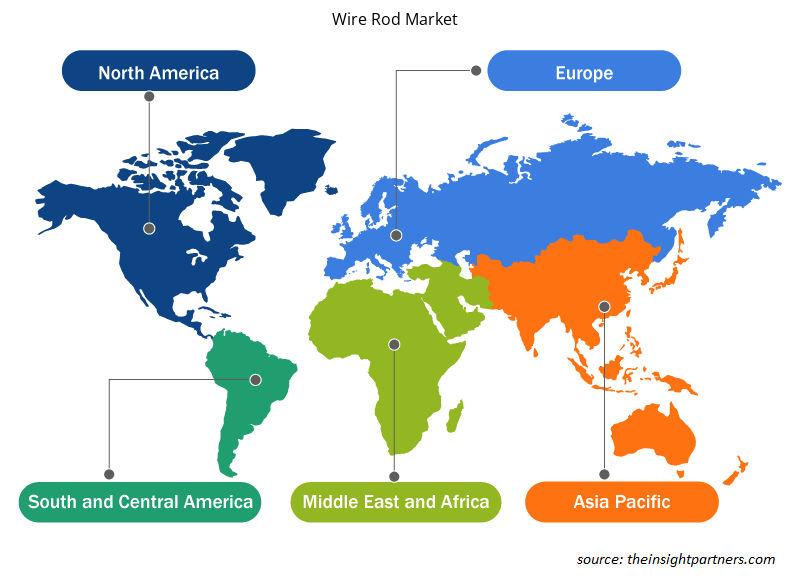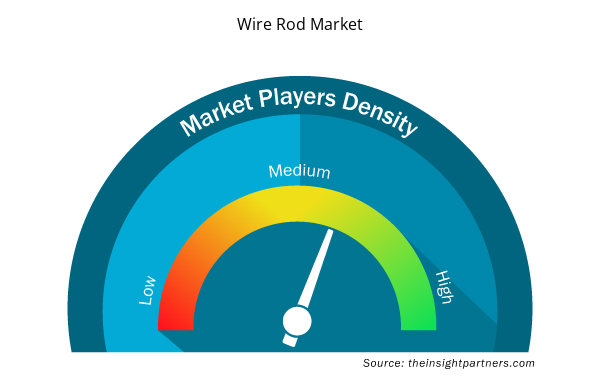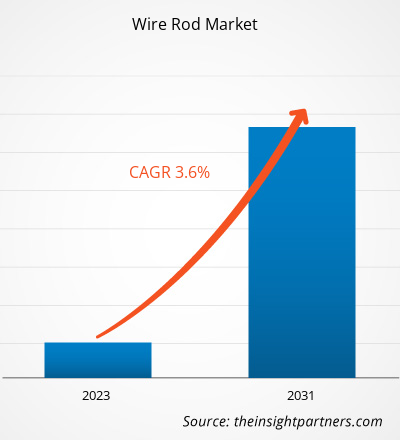Wire rod market size is projected to reach US$ 2,225.04 million by 2031 from US$ 1,678.14 million in 2023. The market is expected to register a CAGR of 3.6% in 2023–2031.
A wire rod is made by drawing hot metal through shafts. These shafts form and compress the metal from all sides, thus turning a piece of metal into a long and thin wire. They have round cross-sections and are wound up in the coil. They act as excellent raw materials for high-voltage cable and wire manufacturing. These wire rods are used to carry loads, electricity, and telecommunications signals. They are used in various sectors, including electrical, infrastructure, aviation, telecommunication, and automotive. For example, wire rod is used in multiple electronic components, telecom cables, sockets, and terminal blocks.
Wire Rod Market Analysis
The construction projects of commercial, industrial, and residential buildings are growing across the world, majorly in developing countries such as China, India, Malaysia, Poland, Saudi Arabia, and the UAE. This factor is projected to fuel the demand for products such as wires, wire ropes, wire and cables in various electrical and electronic applications. Hence, with rising construction activities, the scope of using different wire rods will endure to boost. For instance, in February 2023, Vedanta Aluminium introduced a 12 mm aluminum wire rod for the electrical industry at the International Aluminium Conference (IAC) 2023
Wire Rod Market Overview
Wire rod is a rolled steel product produced from rectangular or cylindrical steel. Wire rods are wounded into coils and transported into the form of wires. These wire rods are widely used to manufacture welding wires, electrodes, electrical cables, reinforcement strands and fibers. Wire rod has a wide range of applications, including tie wires, meshes, fencing, shopping carts, shelving, wire hangers and nails. In addition, wire drawn from the rod is painted, galvanized, and plated.
Customize This Report To Suit Your Requirement
You will get customization on any report - free of charge - including parts of this report, or country-level analysis, Excel Data pack, as well as avail great offers and discounts for start-ups & universities
Wire Rod Market: Strategic Insights

- Get Top Key Market Trends of this report.This FREE sample will include data analysis, ranging from market trends to estimates and forecasts.
Customize This Report To Suit Your Requirement
You will get customization on any report - free of charge - including parts of this report, or country-level analysis, Excel Data pack, as well as avail great offers and discounts for start-ups & universities
Wire Rod Market: Strategic Insights

- Get Top Key Market Trends of this report.This FREE sample will include data analysis, ranging from market trends to estimates and forecasts.
Wire Rod Market Drivers and Opportunities
Increasing Construction and Infrastructure Development Activities
Wire rods are developed by using continuous casting technology. An increase in the construction of industrial plants, including electrical industries, will propel the scope of wire rods. According to the TASS (a Russian news agency), the commissioning of housing in Russia increased by 28.4% in the first five months of 2021 compared to 2020. According to the Ridgewater Homes website data, Australia witnessed a 10% growth in the construction of residential buildings in 2021. This growth is attributed to the increasing demand for houses due to sustained employment, record-low interest rates, and surging government programs such as HomeBuilder. HomeBuilder is an Australian Government initiative to aid confidence in residential construction sector buyers for procuring or renovations, which might get delayed owing to uncertainty caused by the pandemic.
Furthermore, several government initiatives are supporting the growth of the housing industry. For instance, in February 2021, according to the Yonhap News Agency website, the South Korean government announced that they would ease building regulations and support redevelopment projects in urban areas of the country by supporting the construction of 836,000 new houses nationwide. Also, the new housing policy by the government focuses on increasing the number of houses in the Seoul metropolitan area and other major cities.
Growing Investments in Electric Power Transmission and Distribution
The growing urbanization and digitization across the world are raising the demand for uninterrupted electric supply. For this, the need for the upgradation or installation of new electric transmission and distribution systems is increasing globally. Subsequently, governments of various countries have increased their investments in the power & energy sector. For instance, in November 2022, the US Department of Energy (DOE) announced an investment of US$ 13 billion in supporting the upgradation and expansion of the US electric grid. The US government will provide this funding under the Grid Resilience Innovative Partnership (GRIP) Programme, the Transmission Facilitation Programme, and President Joe Biden’s Bipartisan Infrastructure Law. Through this funding, the US government aims to increase the reliability of power grids by building transformative projects. In November 2022, Ofgem, an energy regulator of the UK, announced the five-year (between 2023 and 2028) investment package of ~US$ 26.6 billion for electricity distribution network companies. This investment is made to help deliver cheaper and cleaner energy and increase the reliability of local grids with no extra cost to consumers.
Rising Adoption of Electric Vehicles
Wire rod is an important part used in various EV components such as motor, onboard charger, battery, and Electric Power Control Unit (EPCU). Increasing demand for zero-emission vehicles and growing supportive regulations for zero-emission vehicles through subsidies and tax rebates have compelled manufacturers to provide electric cars across the world. When switching to an electric vehicle (EV), customers expect a high level of automated experience and advanced driving features. Therefore, the growing technological innovation in EVs will raise the demand for wire rods.
As per the Global Electric Vehicle Outlook, sales of electric cars, including fully electric and plug-in hybrid vehicles, increased in 2021 to a new record of 6.6 million units. As per the same report, in China, electric car sales increased significantly to 3.3 million in 2021, accounting for about half of the total global sales. EV sales in Europe grew strongly by 65% and reached 2.3 million units, and sales in the US doubled to 630,000 units in 2021 from the previous year. Supportive government regulations for electric vehicle charging stations propel the sales of electric vehicles. In June 2022, the US government proposed new standards for its program to build a national network of 500,000 electric vehicle charging stations by 2030. Furthermore, the government had introduced a plan to allocate US$ 5 billion to states to fund EV chargers by 2028. Therefore, the rising sales of EVs are expected to drive the wire rod market in the coming years.
Wire Rod Market Report Segmentation Analysis
Key segments that contributed to the derivation of the wire rod market analysis are material and industry.
- Based on material, the market is divided into copper, aluminum, and others. Copper wire rod provides high conductivity and formability, as well as are ideal for extrusion applications. Backed by the benefits provided by copper wire rods, copper wires are used in switch gears, transformers, and many other electrical applications. Moreover, with rising demand for products such as gaskets, flashlights, handicrafts, terminals, metal zip, metal forming, connectors, lamp caps, electronic components, electrical fittings, hardware, telecommunications, domestic appliances, plumbing products, springs, locks, and automotive radiator, the scope of using copper wire rod will endure to drive the growth of the segment.
- Based on industry, the wire rod market is divided into telecommunication, power, aviation, automotive, and others. The telecommunication industry has the largest share in 2022, owing to the increasing adoption of 5G technologies.
Wire Rod Market Share Analysis by Geography
The geographic scope of the Wire Rod market report is mainly divided into five regions: North America, Asia Pacific, Europe, Middle East & Africa, and South America/South & Central America.
The wire rod market in North America is segmented into the US, Canada, and Mexico. The market growth in this region is attributed to the increasing demand for wire rods in automotive applications. According to the American Automotive Policy Council (AAPC), the automotive industry in the US accounts for ~3% of the country's GDP. Wire rods, particularly aluminum wire rods, are used in precision parts during automotive manufacturing. As they are lightweight yet durable, there is an increasing need for these rods in the manufacturing of different vehicles, such as cars and trucks. In addition, copper wire rods are used in the manufacturing of high-efficiency bar-wound electric motors.
Asia Pacific is expected to have the largest share in 2023. This is owing to the rising production of copper across the globe. According to the World Bureau of Metal Statistics, in 2021, Japan produced around 1.52 million metric tons of refined copper. Out of the total copper produced, it is assumed that approximately 60% of it is used for the production of copper wire rods due to its rising use in the automotive, electronics, and telecom industries. Furthermore, according to the Japan Aluminium Association, in 2021, around 786.6 thousand metric tons of aluminum were produced.
Wire Rod Market Regional Insights
The regional trends and factors influencing the Wire Rod Market throughout the forecast period have been thoroughly explained by the analysts at Insight Partners. This section also discusses Wire Rod Market segments and geography across North America, Europe, Asia Pacific, Middle East and Africa, and South and Central America.

- Get the Regional Specific Data for Wire Rod Market
Wire Rod Market Report Scope
| Report Attribute | Details |
|---|---|
| Market size in 2023 | US$ 1,678.14 Million |
| Market Size by 2031 | US$ 2,225.04 Million |
| Global CAGR (2023 - 2031) | 3.6% |
| Historical Data | 2021-2022 |
| Forecast period | 2023-2031 |
| Segments Covered |
By Material
|
| Regions and Countries Covered | North America
|
| Market leaders and key company profiles |
Wire Rod Market Players Density: Understanding Its Impact on Business Dynamics
The Wire Rod Market market is growing rapidly, driven by increasing end-user demand due to factors such as evolving consumer preferences, technological advancements, and greater awareness of the product's benefits. As demand rises, businesses are expanding their offerings, innovating to meet consumer needs, and capitalizing on emerging trends, which further fuels market growth.
Market players density refers to the distribution of firms or companies operating within a particular market or industry. It indicates how many competitors (market players) are present in a given market space relative to its size or total market value.
Major Companies operating in the Wire Rod Market are:
- Mitsubishi Materials Trading Corp
- APAR Industries Ltd
- Hindalco Industries Ltd
- Norsk Hydro ASA
- Leebo Metals Pvt Ltd
- Sumitomo Electric Industries Ltd
Disclaimer: The companies listed above are not ranked in any particular order.

- Get the Wire Rod Market top key players overview
Wire Rod Market News and Recent Developments
The Wire Rod market is evaluated by gathering qualitative and quantitative data post primary and secondary research, which includes important corporate publications, association data, and databases. The following is a list of developments in the market for innovations, business expansion, and strategies:
- In February 2023, Vedanta Aluminium launched 12 mm Aluminium Wire Rods for the electrical industry at the International Aluminium Conference in 2023. The company has a production capacity of more than 560 kilotons and is equipped with state-of-the-art technologies for producing wire rods. (Source: Eurofins, Press Release)
- Wire Rod Market Report Coverage and Deliverables
- The “Wire Rod Market Size and Forecast (2021–2031)” report provides a detailed analysis of the market covering the following areas:
- Wire Rod Market size and forecast at global, regional, and country levels for all the key market segments covered under the scope
- Market dynamics such as drivers, restraints, and key opportunities
- Wire Rod Market Trends
- Detailed PEST Analysis and SWOT analysis
- Wire Rod Market Analysis covering key market trends, Global and regional framework, major players, regulations, and recent market developments.
- Wire Rod Market Industry, landscape and competition analysis, covering market concentration, heat map analysis, prominent players, and recent developments.
- Detailed Company Profiles
- Historical Analysis (2 Years), Base Year, Forecast (7 Years) with CAGR
- PEST and SWOT Analysis
- Market Size Value / Volume - Global, Regional, Country
- Industry and Competitive Landscape
- Excel Dataset



Report Coverage
Revenue forecast, Company Analysis, Industry landscape, Growth factors, and Trends

Segment Covered
Material, and Industry

Regional Scope
North America, Europe, Asia Pacific, Middle East & Africa, South & Central America

Country Scope
Argentina, Australia, Brazil, Canada, Chile, China, France, Germany, India, Italy, Japan, Mexico, Peru, Russia, Saudi Arabia, South Africa, South Korea, United Arab Emirates, United Kingdom, United States
Frequently Asked Questions
Asia Pacific is expected to dominate the wire rod market in 2023.
Increasing construction and infrastructure development activities across the globe drive the wire rod market growth during the forecast period.
Rising Adoption of Electric Vehicles across the globe is driving the market growth.
Mitsubishi Materials Trading Corp, APAR Industries Ltd, Hindalco Industries Ltd, Norsk Hydro ASA, Leebo Metals Pvt Ltd, Sumitomo Electric Industries Ltd, Vedanta Aluminium and Power Ltd, United Co RUSAL Plc and Vimetco NV.
Wire rod market size is projected to reach US$ 2,225.04 million by 2031 from US$ 1,678.14 million in 2023.
The market is expected to register a CAGR of 3.6% in 2023–2031.

 Get Free Sample For
Get Free Sample For